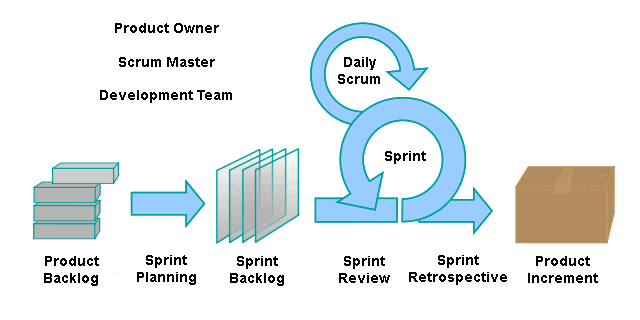What is Scumban? (The Agile Hybrid)
Scrum and Kanban are both known to be Agile flavors. Scrumban, an agile framework for development, is a hybrid of both. It integrates the best features and is ideally suited for product and development programs.
It offers the Scrum structure with the flexibility and visualization of Kanban, making it an extremely flexible approach to workflow management.
Scrum in a nutshell
- Scrum is an agile technique used to develop software. With Scrum, the team arranges itself into particular positions, such as the Scrum Master, the product owner, and the rest of the Scrum team. The team splits its workload into small timelines called sprints. Each sprint usually lasts between 1-4 weeks.

- During the sprint, the developers operate on the projects decided upon by the team in the sprint meeting. Before the next sprint, the team will hold another sprint meeting to determine the things to be done next. Scrum teams also gather for brief stand-ups every morning to discuss the day’s duties.
Kanban in a nutshell
- Kanban is a visual workflow management system that originates in production. Job objects are represented by cards on a board, with lanes indicating process phases — such as “Ready to Start,” “In Progress,” “Under Evaluation,” and “Completed.”

- When developers start working on an object, they move a card with the item’s name from the Ready-to-Start column to In-Progress. It allows teams to evaluate and refine their processes in order to improve lead time, aiming to achieve a consistent, predictable value flow to their clients.
Scrumban = Scrum + Kanban
Scrumban combines the structure of Scrum with the flow-based methods of Kanban.
- Using Scrum’s prescriptive structure to be Agile.
- Using Kanban’s process management to allow the team to consistently develop the process.

Here are the elements of Scrum that are incorporated into the Scrumban method:
- Iteration planning at frequent intervals, aligned with feedback and retrospectives;
- Consider how much work they will do in the sprint on the basis of the difficulty of the work and the duration of the sprint.
- Prioritization on demand – presents the team with the right thing to do next.
- Ensure the required level of analysis before initiating the development process (Definition of Ready)
- Use the “ready” queue (between Backlog and Doing) to coordinate
These are the elements of Kanban that are used by Scrumban teams:
- Pull system and ongoing workflow: take items into Doing.
- WIP Limits: an explicit restriction to how many tasks are in development at any time.
- Individual functions not well described
- Short lead times – prioritize just-in-time analysis and preparation
- Using process buffers and flow diagrams to define process vulnerabilities and areas for change
- Focus more on processing times than on burndown
- Using policies to make changes to the phase stage simpler
How Does it Work? (A 5 Step-by-step Guide)
Scrumban requires utilizing the Kanban principles — workflow visualization and flexible processes — to the Scrum team framework.
Step 1: Develop a Scrumban board
Similar to the Kanban board, add as many columns as you need to identify each distinct step of development.
Step 2: Set your work-in-progress limits
Put a limit to the amount of work the team can do to prevent them from being exhausted and irritated.
Step 3: Order the team’s priorities on the board
Your attention will be on determining the order of importance for all initiatives on the board. Your team will determine which person is going to do the assignments.
Step 4: Throw out your planning-poker cards
The Scrum team has to predict how long each task of production will take. So the poker planning strategy is used to approximate the number of story points (indicating time and difficulty) for each mission.
Step 5: Set your daily meetings
Scrumban meetings can provide quick stand-ups for the team to review their strategies and tasks for the next day.
When to use Scrumban?
Scrumban is a perfect alternative for teams that need the Scrum structure with the simplicity of a flow-based system, or for teams that choose to switch from Scrum to Kanban. Often teams use Scrumban as a transfer point between less and more mature Agil practice.
1. For ongoing project maintenance (Event-driven work / Help desk/support)
2. For a team having problematic projects management (projects with unexpected user stories and bugs)
3. When Sprint teams focused on new product development (work preceding sprint development or following sprint development)
4. Continuous management improvement during/after Scrum roll-out
The Pros and Cons of the Approach
| Advantages | Disadvantages |
| High quality: saved time makes it possible to focus on quality control | There are no good practices as the framework is new. |
| Just-in-time (decisions and facts are only planned when needed) | It may be difficult to track the efforts and contributions of team members. |
| Saving time: no need for estimation or sprint planning. The team only plans whenever there is a demand. | No daily scrum meetings to give managers a glimpse of progress. |
| Reducing waste and anything not adding value to customers | Less control for project managers than traditional PM |
| Continued improvement (Kaizen) | |
| Improvement of the process by introducing some Scrum values if necessary | |
| Perfect viewing of the Scrumban board |

Leave A Comment?